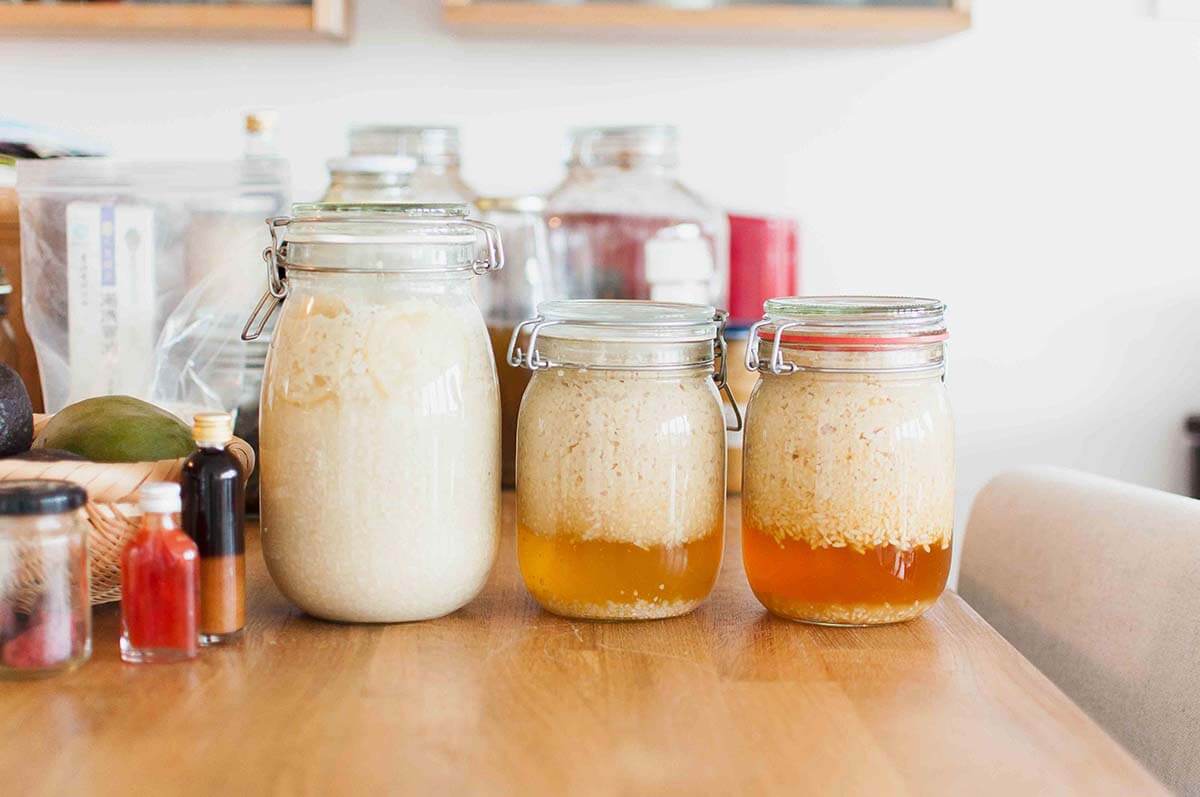Understanding Umami: Let’s Make Amazake and Shio-koji
Last October, American food professionals visited fermented food producers to deepen their knowledge of Japanese fermentation culture during the “Hakko Tourism in Japan” tour campaign. As part of the tour, organizers held a tasting session where guests gave candid advice from the perspective of the American market to food product manufacturers looking to enter the United States market.
The word うま味 (hereafter umami), was invented by a Japanese chemist Kikunae Ikeda (1864 – 1936) who discovered the source of umami in glutamic acid from kombu. Umami can also refer to other tastes in much more food like the ones mentioned above. This means that umami can have several tastes, just like there are many different kinds of sweetness or saltiness.

Shio-koji
Ingredients:
- 1 part of rice koji
- 2 parts of water
- 4-12% salt
Directions:
- Mix koji with salt in a bowl. Break down the clumps.
- Add water and mix well. Put the plastic wrap over it, and leave it at the countertop for 3-5 days in summer, about a week or longer in winter.
- Add a bit of water if koji sticks out of water.
- It might taste salty at the beginning, but it will gradually become mild. Shio koji will become thicker and begin to smell sweet from the fermentation.
- After the fermentation, store it in a fridge.
Tips:
Optionally you could put this in a blender when it’s made for a smoother texture.
How to use shio-koji
- Koji-d vegetables: Marinate chopped vegetables like cucumbers, carrots, daikon, radish, etc.
- Koji-d soup: Use it as salt to season your soup.
- Flavoured shio-koji: Mix it with lemon, onion, ginger, tomato… test your creativity.
- Koji dressing: Mix it with oil, vinegar, and amazake to make your customized dressing (be careful not to shake this, as you may end up cleaning your entire kitchen if the fermentation already took place very actively 🙂 )

Amazake
Amazake (甘酒) is a traditional sweet, low- or non-alcohol (depending on recipes) Japanese drink made from fermented rice.
Ingredients:
- Rice koji 300g
- Cooked rice 300g
- Water 800g
Special tools:
- Thermo bottle
- Thermometer
Directions:
- Measure each ingredient. If your rice koji is frozen, bring it back to room temperature. Break the block apart.
- Make a rice porridge. Place the rice and water in the pan, and loosen the lumpy part of the rice. Put it on a fire and bring it to boil. Lower the fire and cook for about 30 minutes until the rice absorbs the water.
- Cool the porridge to 65°C. In the meantime, pour hot water into your thermo bottle. This is to prevent the mixture to cool down too quickly when you pour it into the next step.
- Mix the porridge and koji. Empty the thermo bottle, and pour the porridge mixture in quickly before the temperature drops too much.
- Keep it between 50-60°C for 6-8 hours.
- Drink it as it is, or diluted it with water as you wish. You can also use it for cooking as a sweetener. Optionally, you could add a bit of ginger.
- Store it in a fridge and finish it within one week.
Tips:
- Even if a week passed, amazake does not get spoiled. Only the taste gets sour, and you can still eat it or use it for cooking (e.g. dressing, etc.).
- If you want to keep it sweet a bit longer than a week, cook it on middle fire after finishing.
Amazake concentrate
This is a condensed version of amazake, using koji and water only.
Ingredients:
- Rice koji 300g
- Water 300g
Special tools:
- Thermo bottle
- Thermometer
Directions:
- Mix koji and water, and keep it between 50-60°C for 6-8 hours. Stir every hour for the first three hours until the koji gets soft (saccharification). After that, leave it as it is while making sure the temperature stays within 50-60°C.
- Store it in a fridge and finish it within one week.
Tips:
- Even if a week passed, amazake does not get spoiled. Only the taste gets sour, and you can still eat it or use it for cooking (e.g. dressing, etc.).
- If you want to keep it sweet a bit longer than a week, cook it on middle fire after finishing.
How to use amazake
- Amazake pudding: Use it as a sweetener to make a pudding using kuzu and fruit.
- Amazake pickled daikon: Salt marinates daikon to squeeze water out, then marinate in amazake with a hint of salt and chili pepper at your taste.
- Mix it with yogurt and serve it with kinako (roasted soybeans powder).
Marika Groen is the head of Malica Ferments, an online platform dedicated to fermented products. As a Kojiologist, traveler, brewer, photographer, and writer, she published the book "Cosy Koji" in 2021, offering insights into the art of Koji making based on her worldwide lectures and experiences.

